New York Yankees: 2018 MLB Draft review and grade

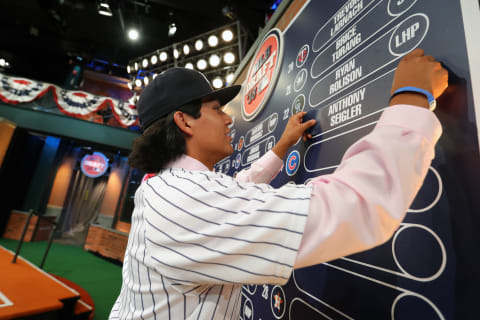
The 2018 MLB draft is over. For the next few weeks, teams will try to sign their draft picks. Let’s look at who the New York Yankees selected.
Another rule 4 draft is complete. And with it, another group of exciting prospects is poised to join the New York Yankees farm system. Coming into the season, the New York Yankees had one of the top systems in MLB, despite promoting and trading away a ton of talent. Aaron Judge, Jordan Montgomery, and Chad Green all graduated last season.
Miguel Andujar, Gleyber Torres, and Domingo German have all seen time at the major league level this season and will graduate soon. Despite that, this is still an incredibly deep farm system. That means the Yankees had a lot of leeway in developing a strategy for the 2018 MLB draft.
The days of simply throwing money around to get the top talent to fall to the bottom of the first round or the latter rounds are over. That’s thanks to the new CBA. There are ways for teams to game the system a bit, but they are limited which evens the playing field a bit.
The mechanics of the 2018 MLB Draft.
Teams are granted a bonus pool each year based on their position in the draft order and how many picks they make. Each team has at least 40 picks, one in each round. Some teams are also granted competitive balance round picks for being in the 10 worst markets or having one of the 10 lowest revenue pools.
The Yankees qualified for neither. Then there are compensation picks for losing players to free agency after making a qualifying offer to them. All told, the Yankees had the minimum 40 picks and $6,115,100.00 to spend.
This pool is tied to their first ten rounds of picks. Any pick made in rounds 11-40 has a cap of $125K with any overage coming out of the bonus pool from rounds 1-10. The pool from those first ten rounds is contingent upon signing your picks in those slots. If a team fails to sign a pick in the first ten rounds, they lose the slot allotment for that pick.
That means teams will often pick players in the early rounds that can be expected to sign for significantly under slot value. This allows them to pay other players, inside the first ten rounds or out, more than the slot allotment for their pick.
The Yankees had options.
Typically, teams don’t draft for need. For the most part, selections are made with “the best player available” as the driving force. That said, these picks are made with some context in mind. The Red Sox, for example, had a very thin system and needed to take some chances with their picks. They selected a number of high ceiling players that also carried a significant amount of risk.
With such a strong farm system, the Yankees had the option of taking risks on high ceiling players. A lot of the time, this can mean drafting plenty of prep bats and arms. There are certainly high ceiling college players available in every draft, but they tend to go early.
They could also stock up further on draftees with lower ceilings but a better chance to be useful major leaguers. So which path did the Yankees choose? Did they hedge their bets and go with a mix? Let’s dig in and see!
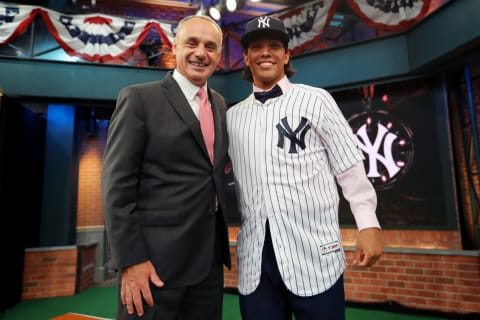
The day one picks.
New York Yankees 2018 MLB Draft Pick #1 – Anthony Seigler, C – Cartersville HS (GA)
This may seem like an odd pick. Anthony Seigler was ranked 46th overall by MLB Pipeline, exactly twice the 23rd pick he was selected with. Baseball America had him ranked 41st, so either way, this looks like a reach.
And that’s the thing about the MLB draft; you can’t just go by pre-draft rankings and assert one pick is a reach while another is a steal. These rankings are highly subjective and should only be considered a rough guide.
In this case, the Yankees have drafted a fairly rare asset. Seigler is a switch-hitting catcher who is also a switch pitcher. That’s right, he bats from both sides of the plate and throws with both arms. His future as a pro is behind the plate, however, so his ability to pitch with either hand will carry forward as more of a quirk. He has a commitment to Florida, but the Yankees wouldn’t have picked him in the first round if they thought he might not sign.
What does he bring to the table?
Anthony Seigler is a solid defensive catcher with a strong arm and well rated receiving skills. Baseball America cites 2.00 pop times among his strengths (that’s already a major league average skill). He hits well from both sides of the plate, though is more of a gap to gap hitter than a home run threat.
The Yankees have raved about his well-rounded skill set and his makeup. As a high school draftee, he will likely have enough leverage to command an above-slot bonus. With the allotment for the 23rd pick being just over $2.8M, don’t be surprised to see the announced figure north of $3M.
New York Yankees 2018 MLB Draft Pick #2 – Josh Breaux, C – McLennan JC (TX)
Another catcher, Josh Breaux (pronounced “bro” by Nick Swisher on Monday night) was ranked 71st overall by MLB. Baseball America had him at 88th. He is a draft-eligible sophomore coming out of junior college who has also spent time on the mound. He doesn’t appear to want to pitch as a pro, however. That does mean he has a plus arm behind the plate. In fact, he has more than that in common with current Yankees backstop Gary Sanchez.
Like Sanchez, he has big raw power, patience, and is a bit stiff defensively overall. That said, Breaux has more swing and miss in his game but also more speed. He could, potentially, play some outfield. Despite the swing and miss, he did have more walks than strikeouts this year. He has a commitment to Arkansas but is likely to sign. Since he is just a sophomore and has a commitment to a big-time school, this will be another over-slot bonus. Perhaps in the $1.5M range.
Day two: Rounds three through ten.
New York Yankees 2018 MLB Draft Pick #3 – Ryder Green, OF – Karns HS (TN)
A high school outfielder, Ryder Green was selected more or less where his rankings suggested he should be. He is a toolsy player with plus power generated by excellent bat speed and plenty of strength. What’s more exciting is that he spent the spring using a wood bat and continued to produce. He is one of the best power hitting high school bats in the draft class.
While raw defensively in the outfield, he does have the tools to be an average or better defender in time. His arm is plus, and his speed is anywhere from average to plus, depending on which scout you ask. He has played second and third base throughout high school, with a bit of center field as well. Green will move to a corner as a pro.
Will he sign?
This is the first questionable draftee regarding the likelihood to sign. For the most part, players drafted in the first ten rounds do sign. The percentage is overwhelming. But Green has a strong commitment to a powerhouse baseball school in Vanderbilt.
Prying him away won’t be cheap, and this might be the biggest over slot bonus the team has to offer. With a slot allotment of $576,400.00 for the pick, the Yankees will certainly be going over. This may cost them something closer to their first-round bonus to get done.
Of course, the Yankees would not have used a third-round pick on him if they weren’t willing to go far enough to sign him. Chances are they had discussions with him before making the pick and know what he is asking for. And they had seven more picks with which to save some cash to get there.
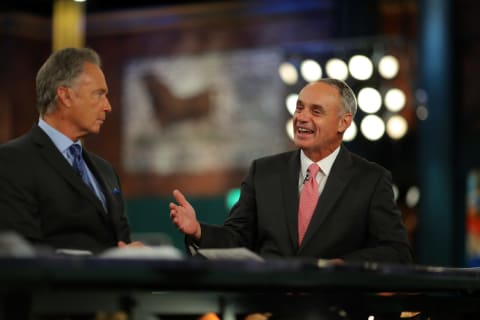
New York Yankees 2018 MLB Draft Pick #4 – Frank German, RHP – University of North Florida
Given the expected cost on Ryder Green, the Frank German pick makes a lot of sense. MLB had him ranked 191st and BA at 157. With this being pick 127, there’s likely some savings on the table here. As a college junior, he has some leverage in that he could go back to school.
But unless he expects to propel himself to the top of the draft, there’s a decent chance he wouldn’t be offered as big a bonus next year. College seniors have very little leverage without the threat of returning to school.
As it stands, he has enough to keep his bonus from falling too far below the roughly $430K allotted. But the Yankees could free up $100K or so. What he brings to the table is a plus fastball that sits low to mid 90’s and gets up to 96 at times.
He also has a curveball that has slurvy action and needs work. He may be destined to end up as a reliever because of the lack of secondary pitches. But the fastball is more than good enough to get outs. He dominated the Atlantic Sun Conference with a 1.36 ERA this year.
New York Yankees 2018 MLB Draft Pick #5 – Brandon Lockridge, OF – Troy University
Brandon Lockridge is a speedy outfielder for the Troy Trojans. As a junior this season he moved from second base to center field. This allowed his plus speed to be used to its greatest effect.
At the plate he makes good contact and has improved his patience, leading to a solid .428 OBP. He also nabbed 25 SB in 63 games and was caught just three times. While he doesn’t have much in the way of home run pop at present, he may grow into some as he fills out his frame.
This is likely another under slot signing in the making. He has the option of going back to Troy for his senior year. But his chances of being drafted significantly higher aren’t good. And without the threat of going back to school again after next season, the offer he would get would certainly be lower. The slot allotment for this pick is $320,700.00. Chances are the Yankees will be able to shake another $100K or more loose from this pick.
New Yankees 2018 MLB Draft Pick #6 – Rodney Hutchison, RHP – University of North Carolina
His fastball is solid, but not spectacular. It lives in the low to mid 90’s. Though he did touch 96 during the ACC tournament. He also has a plus changeup, and a show me a slider.
Baseball America ranked him 462nd out of 500 draft-eligible players. This pick was the 187th of the draft. He was a junior this year and could return to school, but his prospects for improving his draft slot or the bonus he will be offered aren’t great. He may sign for significantly below the $247,600.00 allotment.
New York Yankees 2018 MLB Draft Pick #7 – Daniel Bies, RHP – Gonzaga University
At 6’8, 245 pounds, Daniel Bies is one of the largest players drafted this year. He is a redshirt junior, who had Tommy John surgery before his freshman year.
His first two seasons after the procedure weren’t exactly pretty, posting ERAs of 4.91 and 5.20. But he took a massive step forward this season, finishing the year at 2.49 with 124 K in 112 IP. He throws a mid 90’s fastball with an above average breaking ball. His height gives his heater great downward plane.
Another junior who likely won’t see his draft position or bonus amount improve dramatically by returning for his senior year, Bies will likely sign a below slot deal.
Especially given his injury history. It is in his best interest to get his pro career started as soon as possible. The slot allotment for this pick is $194K, most of which will be available for over slot draftees.
New York Yankees 2018 MLB Draft Pick #8 – Connor Van Hoose, RHP – Bucknell University
Connor Van Hoose is an unranked player in either MLB or BA’s lists. He is a senior draftee, meaning his has very little leverage in negotiations despite stellar results throughout his college career. The 6’1 righty finished the season with a 2.36 ERA, striking out 108 over 76.1 IP. He works with a fastball, curveball, and slider mostly.
As a college senior the Yankees will likely save the vast majority of the $159,800.00 allotted for the pick. Though, as far as college senior picks go, this one is quite intriguing. Consistently dominant results like his hint at a relatively high floor. And as a full four-year pitcher out of college, he could move through the system quickly.
New York Yankees 2018 MLB Draft Pick #9 – Mick Vorhof, RHP – Grand Canyon University
This is another college senior pick. Mick Vorhof is a 6’1 right-handed pitcher out of Grand Canyon University. While a starter initially, he transitioned to the pen and was absolutely phenomenal there this season. He posted a 2.35 ERA with 48 K in 38 IP. That makes him another intriguing low-cost sign. Not only is he a college senior, but his being a reliever means he could fly through the minors.
This is another college senior pick. Mick Vorhof is a 6’1 right-handed pitcher out of Grand Canyon University.
While a starter initially, he transitioned to the pen and was absolutely phenomenal there this season. He posted a 2.35 ERA with 48 K in 38 IP. That makes him another intriguing low-cost sign. Not only is he a college senior, but his being a reliever means he could fly through the minors.
New York Yankees 2018 MLB Draft Pick #10 – Josh Maciejewski, LHP – UNC Charlotte
Josh Maciejewski is a big lefty at 6’3 and 210 pounds. He throws a fastball that lives in the low 90’s while featuring a changeup and a slider. He struck out a batter per nine innings in his senior year and posted a 2.25 ERA.
His previous three seasons weren’t nearly as good as his final year, but the results were good enough to get him drafted here. This is another big money saver for the Yankees.
The slot allotment is $137,800.00, and the Bronx Bombers can probably banks around $130K of it. It’s conceivable that the Yankees will have freed up anywhere between $600-850K with their day two picks. So what will they use those savings on?
Day three: A place to spend the rest of your bonus pool.
New York Yankees 2018 MLB Draft Pick #11 – Tanner Myatt, RHP – Florence-Darlington Tech JC (SC)
This may not cost a bonus in excess of the $125K cap, but it is a pick worth noting. Tanner Myatt is a second-year junior college right-handed pitcher. At 6’7, 205 pounds, he is extremely long and lanky, which he uses to generate some excellent velocity. His fastball lives in the mid 90’s and has been clocked as high as 99 MPH.
This may not cost a bonus in excess of the $125K cap, but it is a pick worth noting. Tanner Myatt is a second-year junior college right-handed pitcher. At 6’7, 205 pounds, he is extremely long and lanky, which he uses to generate some excellent velocity. His fastball lives in the mid 90’s and has been clocked as high as 99 MPH.
New York Yankees 2018 MLB Draft Pick #13 – Isaiah Pasteur, OF – George Washington University
Isaiah Pasteur is another pick that won’t chew up any of the bonus pool that the Yankees have to play with after signing their first ten rounds of picks. He’s a college senior draftee and won’t have much leverage in negotiations.
What he does have, however, is excellent speed on the basepaths. Pasteur swiped 30 bags in 33 attempts this spring. He also had seven triples.
With a .341/.405/.600 triple slash and 10 HR, he also has enough pop in the bat to provide value at the plate in addition to on the bases. He is capable of playing both in the outfield and the infield as well. He doesn’t profile as a likely starting caliber player at the major league level, but his tools could make him a nice bench option down the road.
New York Yankees 2018 MLB Draft Pick #15 – Nick Ernst, RHP – University of Miami (Ohio)
We still haven’t reached the point where the Yankees have drafted a player likely to go over the $125K cap for picks in rounds 11-40. Here we are looking the team betting on finding some excess value in an asset that has intriguing upside but missed most of the year recovering from Tommy John surgery.
Nick Ernst was poised to have a breakout season before the injury, with a fastball that lives in the low to mid 90’s. He also throws a slider with some potential.
While just a junior, Ernst is between a rock and a hard place. Given the fact that his injury occurred early in the season, he may not be full recovered until his senior season is nearly over.
That means even if he makes a full recovery, he’d be re-entering the draft as a senior that has no leverage. And he’d have no opportunity to show just how good he is when healthy.
If the Yankees are willing to go anywhere near the $125K they can offer him, it would almost certainly be more than he’d be likely to get next June.
So the Yankees have an opportunity to land a promising college junior without having to touch their bonus pool. It’s virtually all upside for the team — and is likely too good of an opportunity to hedge his bets for Ernst to pass up.
New York Yankees 2018 MLB Draft Pick #31 – Patrick Winkel, C – Amity Regional High School (CT)
This is the first tough sign of day three. Patrick Winkel is a big high school catcher who projects to develop some intriguing tools, including power.
He’s 6’2 and 185 pounds and will likely pack on some muscle as he gets older. While his arm is just a bit better than average, he already displays fairly polished defensive skills behind the plate.
The bat is still a work in progress, but again, the projection is intriguing. He has a commitment to the University of Connecticut. UConn is the school that produced George Springer, as well as Red Sox reliever Matt Barnes.
The ability to lure Winkel away from his college commitment will depend heavily on how much of their bonus pool is left to offer following their day 1 and two signings.
New York Yankees 2018 MLB Draft Pick #35 – Austin Wells, C – Bishop Gorman HS (NV)
With their 35th round pick, the Yankees changed things up and drafted… another catcher. Austin Wells is a big, physical 6’2, 195-pound specimen. Unfortunately, he has been nursing an elbow injury in his throwing arm all year which has limited his ability to show off his skills. Before the injury, he showed above average power and an above average arm. He is ranked 206th by Baseball America.
It is likely in Wells’ best interest to go to school and raise his draft stock. He has the tools to be worth a much higher draft pick in a few years. If so he could command a significantly higher bonus.
This is likely one of those picks a team makes late in the draft in case another over-slot deal falls through. When that happens, they can throw the money at a player like Wells and hope to convince them to sign.
Landon Marceaux may be the Yankees top target from day three. He is an impressively advanced right-handed pitcher. He has significantly more command than you would typically see from a prep pitcher, with some scouts projecting a 70 down the road.
Add that to the fact that he throws in the low 90’s already, and you have a great foundation. But that’s not all. He also throws a sinker, a curve, and a changeup that may become plus.
As far as high school pitchers go, he’s about as complete a package as it gets. The concern is his size, standing just 6 feet tall at 185 pounds. That’s not tiny, but for a starting pitcher teams like to see a bit of a larger frame. Throwing 200 innings per year is incredibly taxing on the body. That said, he was still ranked 109th by Baseball America. Landon Marceaux is a Louisiana State commit, and a tough sign. Expect the Yankees to make a big push to try and get him locked up.
New York Yankees 2018 MLB Draft Pick #39 – Brady Allen, OF – Jenkins HS (FL)
Finally, we have Brady Allen, a toolsy but raw outfielder out of Jenkins high school in Lakeland Florida. Allen is 6’1 and 200 pounds and projects to fill out a bit more as he matures. He has some swing and miss in his approach at the plate and hasn’t displayed much power yet. For the most part, he’s pure projection.
Allen will likely be best served by honoring his commitment to South Carolina. That will give his tools a chance to develop and increase his draft stock for 2021.
The Yankees may throw enough money at him to convince him to sign if they find themselves unable to lock up another day three draftee. But it will likely take a significant bonus to do so.
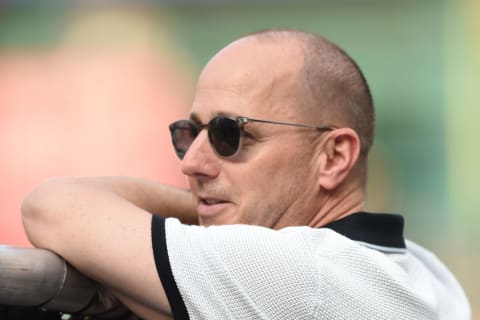
Clouded, the future is
The draft is a complicated thing. It’s possible that the best player drafted this year isn’t even one from this write-up. After all, Don Mattingly was a 19th round pick in 1979 and likely wouldn’t have made a list like this.
But with that aside, we can place this draft into some context by looking at what strengths the current farm system possesses.
At this very moment, the top prospect in the system at MLB Pipeline is Estevan Florial. He is followed by Justus Sheffield, Albert Abreu, and Chance Adams. There aren’t any standout, obvious future stars in the top 30.
Although, that doesn’t mean there aren’t any in there. But the strength of the system is depth. To illustrate the point, I’ll compare it to a system I’m more intimately familiar with; the Boston Red Sox.
I have to go down to number 10 in the system, Matt Sauer before I find a name I wouldn’t immediately slot into the BoSox top 5. If I look at it the other way, I need only get to 14 or so before I’m pretty sure no more prospects from the Red Sox could make the top 30 for the Yankees.
Said differently, if I did a top 30 from both teams together, it might be about half and half, but the top half would be nearly all Yankees prospect.
The Yankees system may lack a top 15 prospect in the game, but the drop off from number 10 in the system to number 20 isn’t all that big. So how does that inform a grade for the Yankees and this year’s draft?
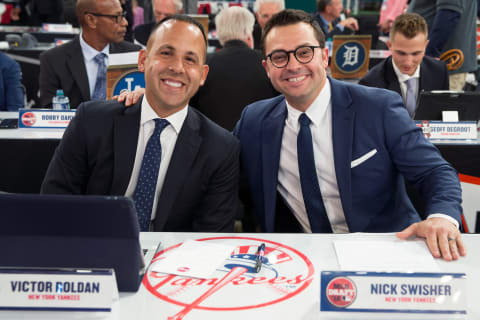
A deep system provides a safety net for taking chances.
Unlike the Red Sox, who had to take chances with this draft because of how thin their system was, the Yankees could have played it safe. Doing so would have fed even more depth into the system and kept it producing solid major leaguers for another few years.
And that path would have been fully justifiable. But that safety net means they also had the option to take some risks. Because even if those risks don’t pay off, the system is still in good shape.
But that’s not quite what they did. Instead, they appear to have split the difference. It’s incredibly likely that Seigler, Breaux, and Green will sign. And they will almost assuredly ink one of Winkel, Marceaux or Allen.
That means they should leave this draft with at least four intriguing new prospects and a number of others with enough upside to hope on. I’m on the fence between a C+ and a B-, but if for no other reason than the sheer novelty of Anthony Seigler’s switch hit/pitch ability, I’ll go with the higher grade. So B- it is.
We demand you justify that grade!
Okay, no problem. The Yankees were in a position to take some serious risks in this draft. While they took some, they seem to have played it safe more than I would have liked them to. With such a deep farm system, this was a great time to reach for the stars. Maybe Seigler becomes one, but he lacks any plus tools.
And that first round pick was their best opportunity to snag a player with that kind of upside. In fact, they let Triston Casas slip past them, which I was very surprised by. His left-handed power in Yankee Stadium would have been a treat (or a horror show for the rest of baseball to be subjected to).
In the end, they pulled in a few interesting prospects and should be able to sign one or two of their round 11-40 draftees. But again, I do not see the future stars there. Productive major leaguers? Yeah, sure. But stars? Eh. The only one who looks like a future star, if you squint a bit, is Ryder Green. And he’s the real reason I went B- instead of C+.
Next: Bumgarner a Yanks trade target?
In the end, they pulled in a few exciting prospects and should be able to sign one or two of their round 11-40 draftees. But again, I do not see future stars there.
Productive major leaguers? Yeah, sure. But stars? Eh. The only one who looks like a future star, if you squint a bit, is Ryder Green. And he’s the real reason I went B- instead of C+.